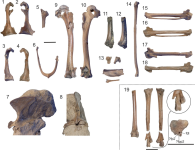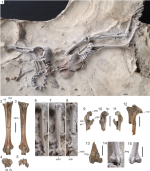Fred Ruhe
Well-known member

Gerald Mayr & Andrew C. Kitchener, 2023
Early Eocene fossils elucidate the evolutionary history of the Charadriiformes (shorebirds and allies).
Journal of Paleontology
doi: 10.1017/jpa.2023.51.
Non-technical Summary.—Shorebirds and allies form the avian order Charadriiformes and have a poor early Cenozoic fossil record. We report charadriiform and charadriiform-like birds from the early Eocene London Clay of Walton-onthe-Naze (Essex, UK). A partial skeleton of a small modern-type charadriiform is described as a new species, Charadriisimilis essexensis n. gen. n. sp., and most closely resembles species of the Charadrii, the group including plovers, stilts, oystercatchers, and other “wader-like” shorebirds. With an age of about 53 million years, this is one of the geologically oldest charadriiform species known to date. The new material also includes fossils of the charadriiform-like taxon Scandiavis, which was before known only from the early Eocene Fur Formation in Denmark. Scandiavis is the best-represented archaic charadriiform bird, and together with the more “modern-type” Charadriisimilis, it informs the evolutionary history of charadriiform birds.
Abstract:
 www.cambridge.org
www.cambridge.org
We report charadriiform and charadriiform-like birds from the early Eocene London Clay of Walton-on-the-Naze (Essex, UK). A partial skeleton of a small modern-type charadriiform is described as a new species, Charadriisimilis essexensis n. gen. n. sp., and most closely resembles taxa of the Charadrii (plovers, stilts, oystercatchers, and other “wader-like” shorebirds). Affinities to this clade were also supported by phylogenetic analyses, which placed the fossil as the sister taxon of either the Burhinidae or all crown group Charadrii. In addition, we identify specimens of the charadriiform-like taxon Scandiavis, which was before known only from the early Eocene Fur Formation in Denmark. Associated limb elements of two individuals are classified as Scandiavis cf. mikkelseni Bertelli et al., 2013, and remains of two further individuals are tentatively assigned to Scandiavis. The presence of a processus supracondylaris dorsalis on the previously unknown humerus corroborates charadriiform affinities of Scandiavis, whereas a plesiomorphic hypotarsus morphology indicates a position outside crown group Charadriiformes. Charadriisimilis essexensis is one of the earliest modern-type charadriiforms, and the holotype of the species is the most substantial early Paleogene fossil record of a charadriiform bird. Together with Scandiavis, as the best-represented taxon to be considered as a stem group charadriiform, it provides the basis for an improved understanding of the evolutionary history of charadriiform birds.
Enjoy,
Fred
Early Eocene fossils elucidate the evolutionary history of the Charadriiformes (shorebirds and allies).
Journal of Paleontology
doi: 10.1017/jpa.2023.51.
Non-technical Summary.—Shorebirds and allies form the avian order Charadriiformes and have a poor early Cenozoic fossil record. We report charadriiform and charadriiform-like birds from the early Eocene London Clay of Walton-onthe-Naze (Essex, UK). A partial skeleton of a small modern-type charadriiform is described as a new species, Charadriisimilis essexensis n. gen. n. sp., and most closely resembles species of the Charadrii, the group including plovers, stilts, oystercatchers, and other “wader-like” shorebirds. With an age of about 53 million years, this is one of the geologically oldest charadriiform species known to date. The new material also includes fossils of the charadriiform-like taxon Scandiavis, which was before known only from the early Eocene Fur Formation in Denmark. Scandiavis is the best-represented archaic charadriiform bird, and together with the more “modern-type” Charadriisimilis, it informs the evolutionary history of charadriiform birds.
Abstract:
Early Eocene fossils elucidate the evolutionary history of the Charadriiformes (shorebirds and allies) | Journal of Paleontology | Cambridge Core
Early Eocene fossils elucidate the evolutionary history of the Charadriiformes (shorebirds and allies) - Volume 97 Issue 4
We report charadriiform and charadriiform-like birds from the early Eocene London Clay of Walton-on-the-Naze (Essex, UK). A partial skeleton of a small modern-type charadriiform is described as a new species, Charadriisimilis essexensis n. gen. n. sp., and most closely resembles taxa of the Charadrii (plovers, stilts, oystercatchers, and other “wader-like” shorebirds). Affinities to this clade were also supported by phylogenetic analyses, which placed the fossil as the sister taxon of either the Burhinidae or all crown group Charadrii. In addition, we identify specimens of the charadriiform-like taxon Scandiavis, which was before known only from the early Eocene Fur Formation in Denmark. Associated limb elements of two individuals are classified as Scandiavis cf. mikkelseni Bertelli et al., 2013, and remains of two further individuals are tentatively assigned to Scandiavis. The presence of a processus supracondylaris dorsalis on the previously unknown humerus corroborates charadriiform affinities of Scandiavis, whereas a plesiomorphic hypotarsus morphology indicates a position outside crown group Charadriiformes. Charadriisimilis essexensis is one of the earliest modern-type charadriiforms, and the holotype of the species is the most substantial early Paleogene fossil record of a charadriiform bird. Together with Scandiavis, as the best-represented taxon to be considered as a stem group charadriiform, it provides the basis for an improved understanding of the evolutionary history of charadriiform birds.
Enjoy,
Fred
Last edited:





